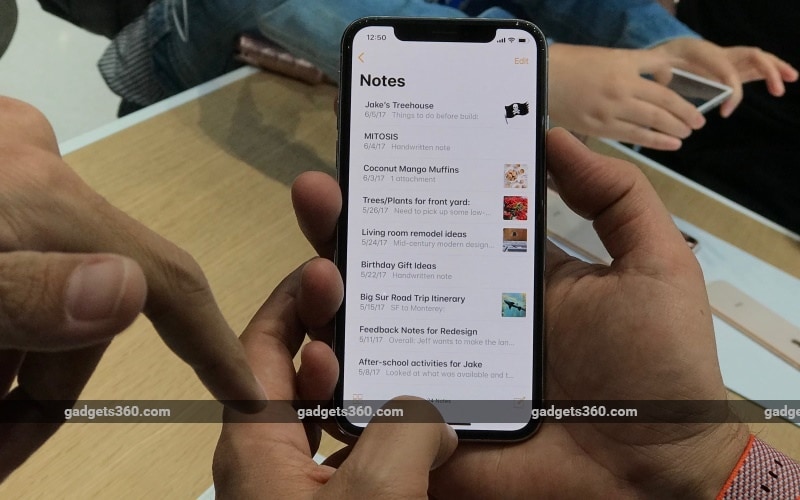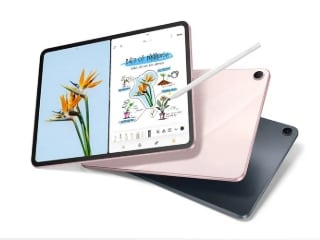- Home
- Mobiles
- Mobiles Reviews
- iPhone X First Impressions
iPhone X First Impressions

In January 2007, Steve Jobs unveiled the original iPhone and the mobile and personal computing industries were never the same again. Ten years later - at a building named after the late Apple co-founder - his successor Tim Cook took the stage to introduce the iPhone X, the phone that he and Apple believe will define the roadmap of the smartphone industry for the next 10 years.
The iPhone X - pronounced iPhone 10 - represents the most radical change to Apple’s design language in the iPhone’s ten year history, as almost the entire face of the phone is now dominated by the display. Save for a small ‘notch’ at the top of the front edge - more on that later - the iPhone X has pretty thin bezels on all sides, though you wouldn't call it 'bezel-less'. This means that the newest, most-expensive iPhone-ever looks nothing like its predecessors, though the overall design is pretty similar to what we’ve seen on a few Android phones, both with and without that notch.
In a body that’s smaller than the iPhone 7 Plus, Apple has packed a display which at 5.8-inches is its largest yet on a smartphone. Belatedly, Apple has caught up with the Android manufacturers when it comes to having a screen-to-body ratio that’s befitting a smartphone shipping in 2017. That’s not all - another piece of tech seen hitherto in smartphones by the likes of Samsung (and others) now makes its iPhone-debut.
OLED panels are seen on Apple-made phone for the first time, ensuring that the all-display front of the iPhone X really catches your eye. At the launch event, Apple said it believes OLED technology is finally at a place where it is able to offer brightness levels, wide colour support, and colour accuracy that the company desires. The ‘Super Retina’ display on the iPhone X ticks all the right boxes when it comes to specifications: 1125x2436 pixels, 458ppi screen, Dolby Vision, HDR10, True Tone, and a one million-to-one contrast ratio. In terms of performance, the iPhone X display is as good as we’ve seen on any smartphone.
![]()
The price you pay for this all-display front is with the loss of the iconic home button and the embedded Touch ID sensor, which have been central to the way we interact with our iPhones since their respective introductions. Instead, you get Face ID, which is enabled thanks to an array of sensors in that notch we talked about earlier. Thanks to a Dot Projector, an Infrared Camera, and a Flood Illuminator, the iPhone X is able to build a 3D model of your face, even in the dark. Apple says this means Face ID cannot be fooled using your picture, or even a face mask that would trick most humans.
![]()
Though we didn’t get to test Face ID using our own face at the hands-on area at the Steve Jobs Theater on Tuesday, based on the demos we saw after the event, this first-generation unlocking technique is definitely slower than Touch ID, which is hardly a surprise. A fairer comparison would perhaps be with face-unlocking implementations of other OEMs, and Face ID seems to ace that test. More when we put the iPhone X through the paces during our review though.
A fun new iPhone X feature that the TrueDepth camera system enables is called Animoji. This lets you send messages where emojis can take your face and voice. While fun, it will be interesting to see if Animojis continue to be used once the novelty wears off. There are other software touches that are different about the iPhone X - you swipe up from the bottom edge to mimic the functionality of the home button; swipe and briefly hold to bring up the multi-tasking view; and slide down from the right of the notch to bring the Control Center into view.
![]()
As you would expect, the iPhone X comes with a bunch of other enhancements: improved cameras with Quad-LED True Tone flash on the rear, the A11 Bionic SoC that’s the fastest-ever smartphone chip on paper, stereo speakers, water and dust resistance, wireless charging, and a whole lot more that we will test in detail over the next few days. Stay tuned to Gadgets 360 for a review of the iPhone X.
Disclosure: Apple sponsored the correspondent’s flights and hotel for the trip to California.
We spoke at length about the iPhone X, iPhone 8, iPhone 8 Plus, Apple TV 4K, and the Apple Watch Series 3 on Orbital, Gadgets 360's weekly technology podcast. You can subscribe to Orbital via Apple Podcasts or RSS or just listen to this episode by hitting the play button below.
Get your daily dose of tech news, reviews, and insights, in under 80 characters on Gadgets 360 Turbo. Connect with fellow tech lovers on our Forum. Follow us on X, Facebook, WhatsApp, Threads and Google News for instant updates. Catch all the action on our YouTube channel.
Related Stories
- Samsung Galaxy Unpacked 2025
- ChatGPT
- Redmi Note 14 Pro+
- iPhone 16
- Apple Vision Pro
- Oneplus 12
- OnePlus Nord CE 3 Lite 5G
- iPhone 13
- Xiaomi 14 Pro
- Oppo Find N3
- Tecno Spark Go (2023)
- Realme V30
- Best Phones Under 25000
- Samsung Galaxy S24 Series
- Cryptocurrency
- iQoo 12
- Samsung Galaxy S24 Ultra
- Giottus
- Samsung Galaxy Z Flip 5
- Apple 'Scary Fast'
- Housefull 5
- GoPro Hero 12 Black Review
- Invincible Season 2
- JioGlass
- HD Ready TV
- Laptop Under 50000
- Smartwatch Under 10000
- Latest Mobile Phones
- Compare Phones
- Honor Win RT
- Honor Win
- Xiaomi 17 Ultra Leica Edition
- Xiaomi 17 Ultra
- Huawei Nova 15
- Huawei Nova 15 Pro
- Huawei Nova 15 Ultra
- OnePlus 15R
- Asus ProArt P16
- MacBook Pro 14-inch (M5, 2025)
- OPPO Pad Air 5
- Huawei MatePad 11.5 (2026)
- Xiaomi Watch 5
- Huawei Watch 10th Anniversary Edition
- Acerpure Nitro Z Series 100-inch QLED TV
- Samsung 43 Inch LED Ultra HD (4K) Smart TV (UA43UE81AFULXL)
- Asus ROG Ally
- Nintendo Switch Lite
- Haier 1.6 Ton 5 Star Inverter Split AC (HSU19G-MZAID5BN-INV)
- Haier 1.6 Ton 5 Star Inverter Split AC (HSU19G-MZAIM5BN-INV)


















